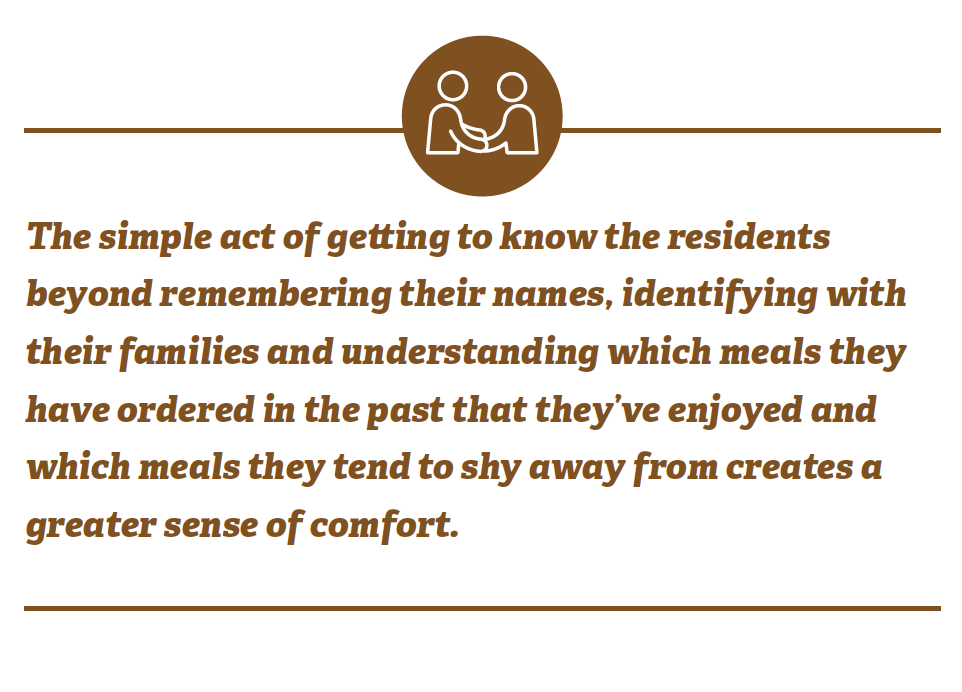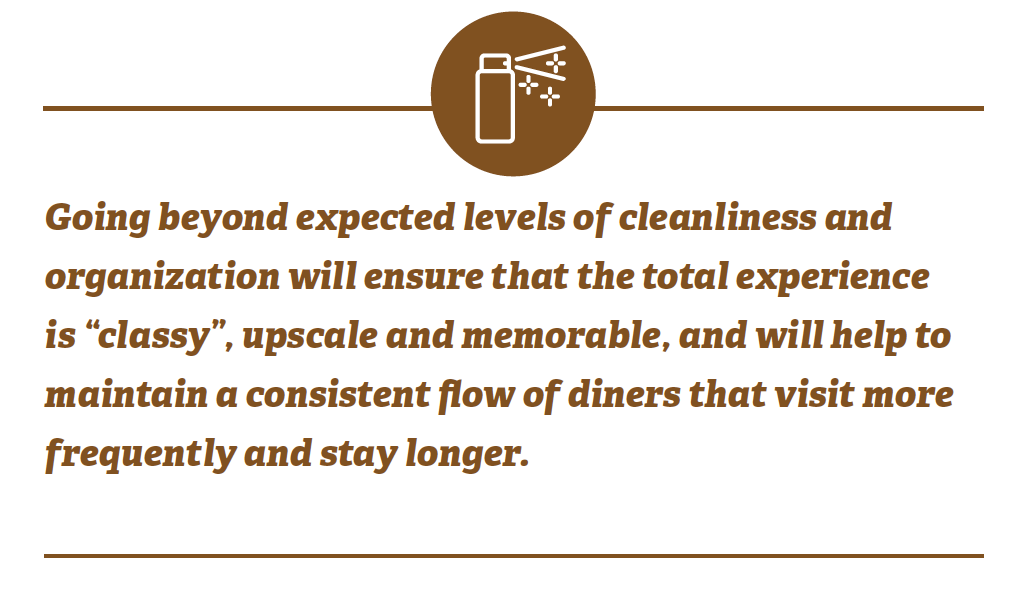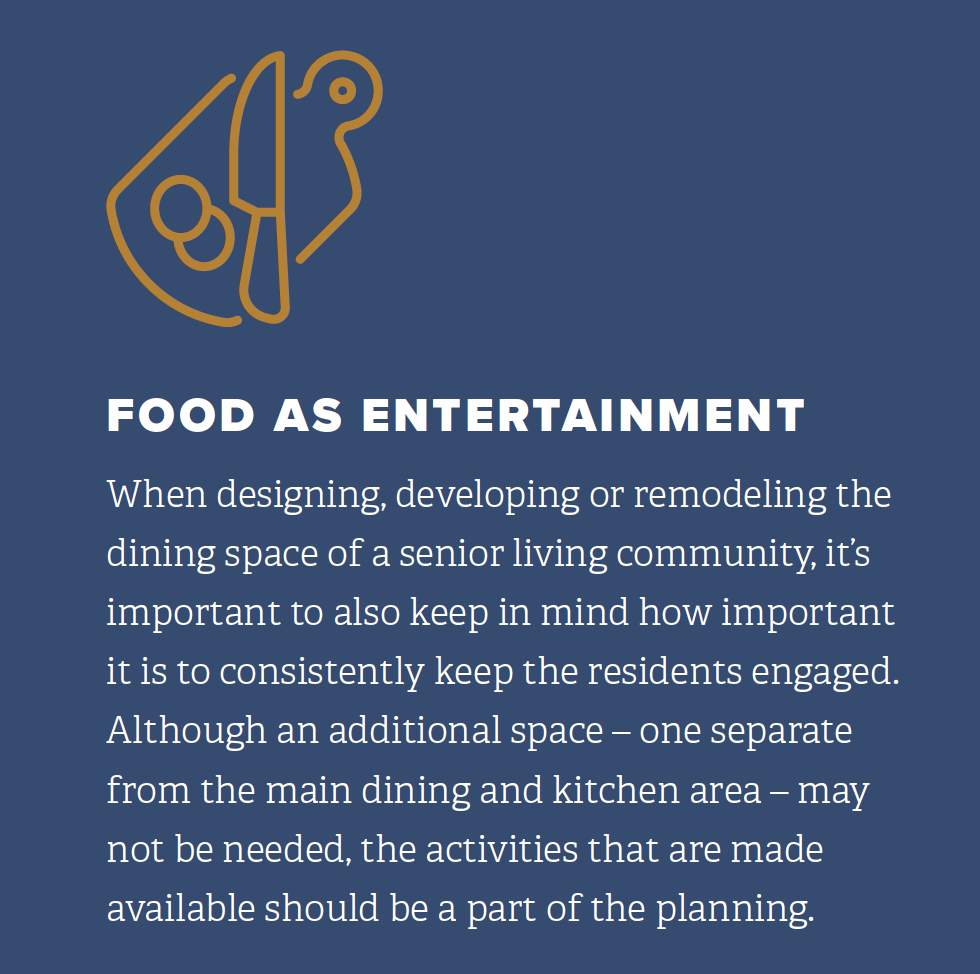
Industry Perspective: Dining Experiences at a Senior Living Community

Within senior living there are differing levels of care and service. Independent living relates to a senior that continues to live on their own in a senior-specific apartment, or a community that accommodates for apartment-style living, has an option for town homes, cottages or duplexes.
Assisted living, on the other hand, traditionally involves a singular living community. One where the residents are all located in the same building. This level of senior living typically includes a specified number of apartments, as well as space for a variety of common areas: dining rooms, activity rooms, a gym and/or physical therapy room, a designated memory care unit and additional options for convenience and comfort like libraries, mini grocery stores and movie theaters.

A senior will generally transition from independent to assisted living when there is an increase in the need for assistance across any of the seven activities of daily living (ADL): bathing and grooming, dressing and undressing, meal preparation and feeding, functional transfers, safe restroom use and maintaining continence, ambulation and memory care, and stimulation. Assisted living communities are only allowed to provide care up to a specified level. When an individual requires assistance with all seven of their ADLs an assisted living community is no longer a suitable or viable living option and the senior is often moved into skilled nursing, or long-term care. However, whether your loved one is in an assisted or independent living community, it is the duty and responsibility of the executive director, administrator and supporting staff to ensure that their residents are being well cared for. This care can be accomplished in a variety of ways and will play a significant role with enhancing the overall quality of life for the senior residents.
A STRONG SENSE OF COMMUNITY Community is often described or defined as consisting of a group of individuals that live in a particular area who are also linked by a common policy, social state or condition. The idea and promotion of “community” is integral to the success of a senior living establishment. Numerous studies point out that social isolation impacts the quality of life and may be a contributing factor to the general health and wellness of a senior citizen. Just as important, nutrition and a well-balanced diet also weigh heavily on a seniors’ health – both physically and mentally. The question then becomes, how does a senior living operation achieve the goal of creating a sense of community for their residents? From a dining perspective, where senior living operations are encouraged to provide restaurant-quality experiences, the role of the restaurant manager, wait staff and even the chefs that prepare the meals all help to maintain that community.

As such, the residents of the senior living community begin to feel more important, feel like they matter and eventually look at the staff as an extension of their own family. From the “back of the house”, the executive chef has an opportunity to involve the resident council – a group of residents selected to provide menu feedback – to further identify specific likes and dislikes, food preferences and requests for any variety of comfort foods associated with holidays, birthdays and other timely events in the lives of the residents. For example, Friday fish fry may have been requested during Lent, followed up with a Ham dinner on Sundays during the month of April. Having the option to work closely with a resident council also eases the decision making when planning out the menu weeks, and sometimes months, in advance.
THE KITCHEN NEVER CLOSES While the kitchen space may be closed at certain times during the day and overnight, and the kitchen staff is unlikely to be available 24/7, there are still viable, healthy options for senior living administrators to consider that further expand the meals that are offered and when (and how) they are made available throughout the community. Regardless of the time of day, these areas of the community allow residents to choose from a variety of options that are simple to prepare and still satisfy certain nutritional levels – a sandwich, a vegetable tray or perhaps a fruit cup. Utilizing an open refrigerator or freezer, capable of accepting credit cards or automatically deducting from the resident’s meal plan allowance is ideal and satisfies a number of needs. For the senior living community, this is also an additional stream of revenue, but one that provides a great deal of flexibility and convenience for those that are taking advantage of it.

In fact, there are a few different food cart styles to be considered. For starters, some food carts are designed more as a market-on-the-go, providing nutritional options similar to the aforementioned grab-and-go design. Hydration carts are also very popular and provide a number of added health benefits. As we age, our overall consumption of both liquids and nutritional foods is reduced. Hydration carts help to ensure that the residents of the senior living community remain hydrated and maintain a healthy weight, reducing the likelihood that they become ill from a urinary tract or bladder infection. To improve overall health and wellness, hydration carts should be circulated throughout the senior living community at various times of the day – morning, afternoon and early evening – proving the residents with a selection of simple snacks, granola bars, fruit and flavored water.

CONVERTIBLE SPACES The current design discussions involving convertible spaces in a senior living community is very much on trend. Similar to a market-on-the-go, convertible spaces utilize a common design but are more focused on an established space within the community – one separate from the main dining and kitchen area. Often, these spaces include a smaller, satellite kitchen to accommodate for a quick plate of bacon and eggs in the morning or freshly prepared sandwiches and simpler hot meals in the afternoon.
Later in the day, these same locations can be briefly closed down as it converts to provide options more in line with a small bar, inclusive of a variety of appetizers. In doing so, this single space, already familiar with the residents of the community, is being used in multiple ways. This transition is a simple and convenient way to further engage a number of different groups that reside within the community. Some may prefer the convenience and small table setting of a bistro, while others like to socialize over a glass of wine and a quick snack. These spaces are created for seniors to gather with one another and feel as if they belong, while continuingly increasing their overall quality of life through much-needed socialization.The size of these spaces often varies based on what the community is attempting to accomplish. Some are designed as smaller venues, accommodating for a dozen or less people, but still providing the benefit of a social environment. Others have been expanded to include larger groups of people. While these additional dining options are important for the residents, they are also important for the families of those residents. Providing these added dining experiences – making them interesting, unique and inviting – may often be the deciding factor when friends and family come to visit and are deciding between taking their loved ones out for a meal or staying on site.
EATING WITH YOUR EYES How important is the overall dining experience when considering table settings, the dress and demeanor of the waitstaff, how the menu choices are prepared and served as well as the total atmosphere and ambiance of the dining room itself?

And just because the majority of the residents at a senior living community are in their 70s and 80s doesn’t mean they don’t still place value on the dining experiences they may have had when they were in their 30s, 40s and 50s. Although, to some, these things may not matter in the long run. They may place more value on the quality of the meal. Others still look for a total package. In the end, administrators of a senior living community should never give their residents a reason to say no when it comes to frequenting the dining space. When the dining area is consistently clean, the staff are courteous, kind and show that they care about their overall presentation, the place settings are nicely displayed and the meals are fresh, nutritious and have restaurant-quality taste, there is little reason for the resident seniors and their families NOT to dine in on a regular basis. The overall presentation matters from the standpoint that you care about the experience you are providing to the residents. Going the extra mile in senior living equates to the differentiation in the food that is offered.

Consider partnering with an executive chef from a well-known local restaurant, for example, to schedule a cooking demonstration. On top of providing the residents with a hands-on activity, there is also the possibility that enough buzz about the event will encourage family members to also attend. Providing that level of entertainment, when combined with a seasonal event or holiday, and ending with a nutritious and delicious meal, is a great way to encourage additional participation throughout the community.
TAKING CARE OF PEOPLE MATTERS MOST At its foundation, senior living communities are about taking care of people. Taking care of our parents, uncles and aunts and ensuring that they are continuing to live their lives to the fullest. Every day, families are faced with the difficult decision to move their loved ones into these various communities to provide them with optimal care. Sometimes these decisions are easy, other times they place an unexpected strain on that family’s relationship. Having the knowledge that your loved one is being offered nutritious meals from a dining experience that encourages socialization and increases their overall happiness, health and well-being makes a significant difference for everyone involved.
See more about Boelter's product offering for senior living communities and see some of our work at senior living communities.